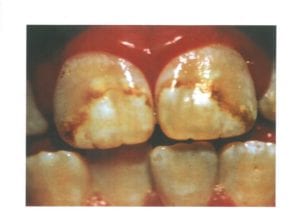Excessive Fluoride in drinking water can affect human health
Have you ever wondered why people develop brownish stained teeth? This has nothing to do with failure to brush their teeth properly but relates more to a disease called dental fluorosis, or mottling of tooth enamel caused by excessive exposure to high concentrations of fluoride during tooth development. Fluorosis is a disease caused by water that contains high amount of fluoride and particularly in groundwater. To investigate this issue, the Water Research Commission (WRC) in partnership with the University of Venda, Department of Hydrology and Water Resources, conducted a study on fluoride concentrations in groundwater and impact on human health in Siloam village, Limpopo Province, South Africa. It was found that most of the inhabitants of Siloam village rely on groundwater for their domestic water use due to the inadequate piped water supply. The findings showed that of 87% of households that use groundwater, an alarming 85% of household members had mottled teeth, and school learners between the age of 11 and 14 also had developed mottled teeth. “Due to the relatively dry conditions in Limpopo province, 75% of the population is dependent on groundwater and use it for drinking and domestic purposes”, explains Professor John Odiyo, Head of Hydrology and Water Resources and the Dean of the School of Environmental Sciences at the University of Venda. “Groundwater in most parts of South Africa is known to have high concentrations of fluoride causing mottled teeth”. Odiyo further comments, “The major problem with Siloam village is that groundwater is frequently used without treatment, exposing the residents to excessive fluoride in groundwater. Groundwater does not form part of the bulk water supply to the village, and thus there is no provision for treatment. The fluoride concentration in Siloam Village is way too high and exceeds the Department of Water Affairs and World Health Organisation’s standards for domestic use”. International studies have shown that water is generally considered safe and healthy at levels used for water fluoridation when present in the concentration range of 0, 7 to 1, 2 mg/L.Some of the studies have also indicated that children of eight years or younger living in areas with natural fluoride concentrations greater than 2mg/L are at risk of severe enamel fluorosis, a condition that causes staining and pitting of the enamel surface of teeth.
Additionally, communities living in areas where fluoride levels are greater than 4 mg/L and having lifetime exposure to fluoride are likely to experience increased bone fracture rates, particularly so for some subgroups that are prone to accumulate fluoride into their bones (e.g. people with renal disease). In South Africa the presence of fluoride on groundwater sources was plotted on Geographic Information System (GIS) map to assess fluoride distribution across the country. The results indicated that the problem of high fluoride ion concentration was prevalent mostly in Limpopo, Northern Cape, North West and Kwa-Zulu-Natal provinces where large populations still live in rural areas with limited treated water supplies. A WRC-funded study published in 2008 also investigated the health and nutritional status of sections of the Northern Cape population in relation to fluoride concentrations in drinking water. The findings showed the presence of fluorosis in different parts of the province varied from mild to severe, with Kamassies, Liliefontein and the peri-urban areas around Kimberly having particularly high frequencies of mild fluorosis. The mild fluorosis prevalent in these areas and, to a lesser extent in Kimberly itself, was inspite of low levels of fluoride (about 0, 34 mg/L). The explanation for the greater than expected occurrence of mild fluorosis could lie in the uptake of supplementary fluoride through toothpastes, milk, etc. The Northern Cape study indicated that fluoride levels of around 0, 3 mg/L generally have beneficial effect on permanent teeth, but have little effect on the primary teeth of young children. According to Dr Nonhlanhla Kalebaila, WRC Research Manager, studies have shown that community water fluoridation is safe and effective in preventing tooth decay– if within the recommended concentrations. The balance of evidence suggests that rates of dental decay are lower in communities with fluoridated water supplies than those with non-fluoridated water supplies. Clearly fluoride levels in drinking water higher than 1, 5 mg/l may cause multidimensional health problems, including not only the mottling of teeth and dental fluorosis but also several neurological disorders. At such elevated levels, the removal of excessive fluoride through defluoridation must be considered. Several methods of defluoridation are available. They generally fall into two categories, namely precipitation and adsorption. There are methods used in developing countries that are suitable for either large-scale fluoridation plants or for domestic/household use. In some cases it would assist to educate residents to avoid using untreated groundwater for cooking or drinking.







